Distributed Systems
Models
Models
Models are used to provide abstract, simplified, consistent description of some aspect of interest of distributed system design.
- physical: describe types of computers/devices that constitute a system and their
interconnectivity without details of specific computer/networking technologies
- most explicit
- considers underlying hardware elements
- architectural: describe system in terms of computational and communication tasks performed
by computational elements
- e.g. client-server, peer-to-peer
- elements: components of the system which interact
- patterns: how components are mapped to underlying system
- middleware: existing solutions to common problems
- fundamental: abstract perspective to describe solutions to particular issues faced by most
distributed systems
- non-functional aspects e.g. interaction, failure, security, reliability, performance
Physical Models
- baseline: extensible set of computer nodes interconnected by computer network for passing of messages
- 3 generations of distributed systems
1970s-80s, early distributed systems
- 10-100 nodes
- local area network, usually Ethernet
- limited Internet connectivity: file transfer, email
- shared local printers and file servers
1990s, Internet-scale distributed systems
- large-scale distributed systems emerged with rapid growth in Internet
- extensible set of nodes interconnected by network of networks (i.e. the Internet)
- significant heterogeneity: networks, computer architecture, operating systems, languages, …
- emphasis on open standards
Contemporary distributed systems
- nodes in earlier generations were primarily desktop computers which were:
- static: not moving around
- discrete: not embedded in other objects
- autonomous: largely independent of other computers
- in contrast, modern distributed systems don’t satisfy these properties:
- mobile computing: nodes have varying location, needing service discovery and spontaneous interoperation
- ubiquitous computing: computers embedded in everyday objects
- cloud computing: pools of nodes together providing a service
Architectural Models
- system architecture: structure in terms of separately specified components and their
interrelationships
- goal: ensure the structure meets present/future demand
- concerns: reliability, managability, adaptability, cost-effectiveness
- architectural elements: interacting components of system
- architectural patterns:
- middleware
Architectural Elements
Building blocks:
- communicating entities:
- system perspective: threads, processes, nodes
- programming perspective: objects, components, web services
- communication paradigm: e.g. message queue, publish/subscribe
- roles and responsibilities: e.g. client, server, peer
- placement: mapping onto physical distributed infrastructure
Communicating Entities
System-oriented perspective
- processes: usually processes are the communicating entities
- threads: strictly threads may be the endpoints of communication
- nodes: sensor networks, OS may not support process abstraction
Problem-oriented perspective
- objects: objects accessed via interfaces
- components: specify interfaces and make dependencies explicit, providing a more complete contract with which to construct the system than objects
- web services: closely related to objects/components. Intrinsically integrated with the WWW,
using web standards to represent and discover services.
- software application identified by a URI with interfaces defined, described, discovered as XML
- supports direct interaction with other software agents via XML message exchange through IP
- objects/components are usually internal to an organisation for tightly coupled applications
- web services are complete services
Interfaces
- interface definition: specifies set of functions that can be invoked by external processes
- programmers need not know underlying implementation of the service, only the abstraction offered
- a stable interface can change transparently
- careful design needed: performance may be impacted if many messages need to be exchanged to get things done
- backwards compatibility/breaking changes need to be carefully considered
- ideally: succinct, expressive
Communication Paradigms
Direct Communication: coupled senders/receivers
- interprocess communication: low-level support for communication between processes in
distributed systems
- message passing primitives, socket programming, multicast
- remote invocation: most common communication paradigm for distributed systems
- 2 way exchange between communicating entities which resulting in remote operation being called
Examples: Remote Invocation
- request-reply protocol: pattern on message-passing to support client-server computing
- pairwise message exchange
- most DS use RPC/RMI, but both are supported by underlying request-reply exchanges
- remote procedure call (RPC): procedures in processes on remote computers can be called
as if they are procedures in the local address space.
- baked in access and location transparency
- remote method invocation (RMI): resembles RPC but in a world of distributed objects
- a calling object invokes a method in remote object
Indirect Communication: allow decoupling of senders/receivers
Uncoupling
- space uncoupling: senders don’t need to know who they are sending to
- time uncoupling: senders/receivers don’t need to exist at the same time
Examples: Indirect Communication
- group communication: delivery of messages to set of recipients; one-to-many
- abstraction of group with an ID, which maintains group membership
- recipients elect to receive messages by joining a group
- senders send messages to the group using the group ID
- publish-subscribe: large number of producers distributing information to a large number
of consumers (with different interests); one-to-many
- uses intermediary service to ensure efficient routing of information from producers to consumers
- message queues: point-to-point service; producer sends messages to a specified queue
- consumer receives messages from the queue
- tuple space: processes can place structured data in a persistent tuple space
- other processes can read/remove tuples by specifying patterns of interest
- readers/writers don’t need to exist simultaneously
- distributed shared memory: abstraction for sharing data between processes that don’t share physical memory
Roles and Responsibilities
- processes, not machines, are the subject of roles
- client-server/centralised: client processes interact with individual server processes
- client processes establish connections with server
- server processes listen for incoming connections
- clients never communicate: everything goes through the server
- most important and most widely used architecture
- peer-to-peer/decentralised: all processes play similar role as peers
- resources of each peer are used, so the system resources scale with the number of users
- substantially more complex than client-server architecture
- any process can make/receive connections from any other process
- no hierarchy: all processes have same capabilities
- in many systems some peers contribute more than others (seed, super peer)
- reliable: no single point of failure: if a client fails, probably won’t be noticed
- available: difficult to deny service for adversaries, as no central point of control
- non-homogeneous: peers likely have different resources
- e.g. BitTorrent
- P2P vs C-S security:
- for client server to be insecure, server has to be compromised. Requires a lot of trust in server: if attacker compromises the server, that’s all that’s needed
- P2P: attacker may have to break many components to take down system/get data
Napster
- hybrid architecture: client/server + P2P
- (C/S) clients send list of music and IP address to index server
- (C/S) another client queries the index server, looking for some music
- (C/S) index server replies with IP addresses of those that have the music
- (P2P) client then establishes connections to these peers to start the download
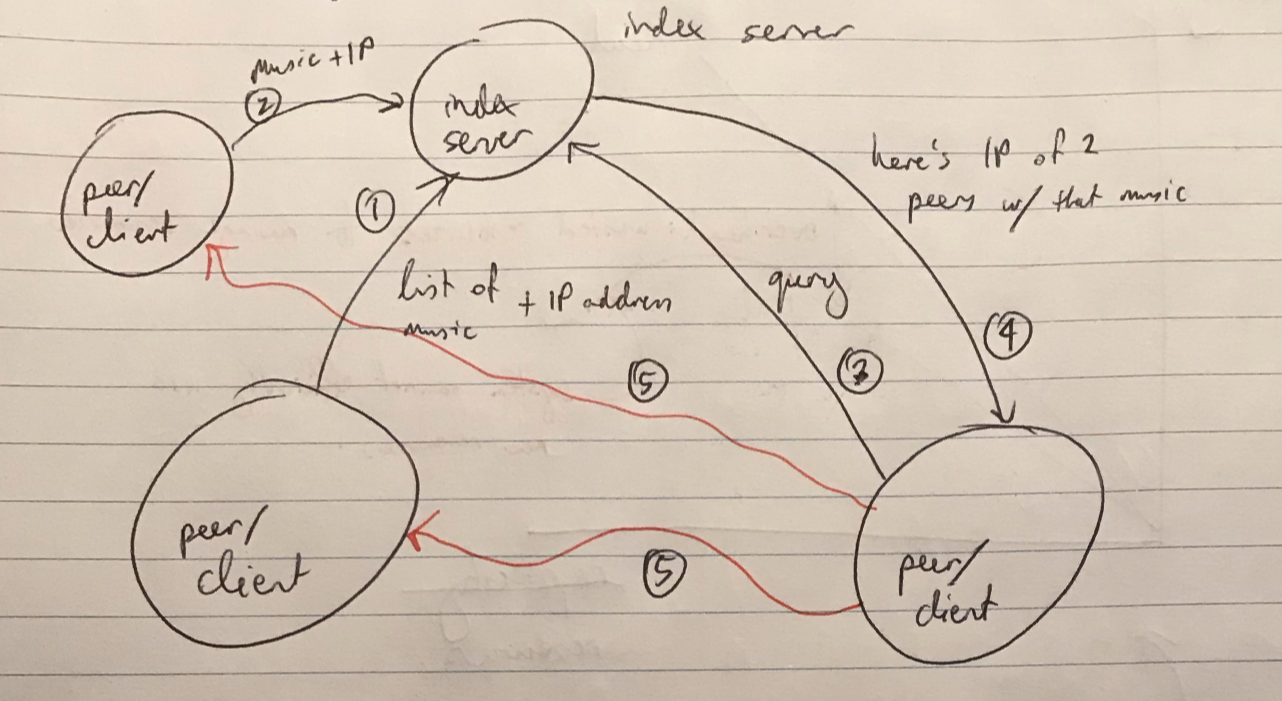
Placement
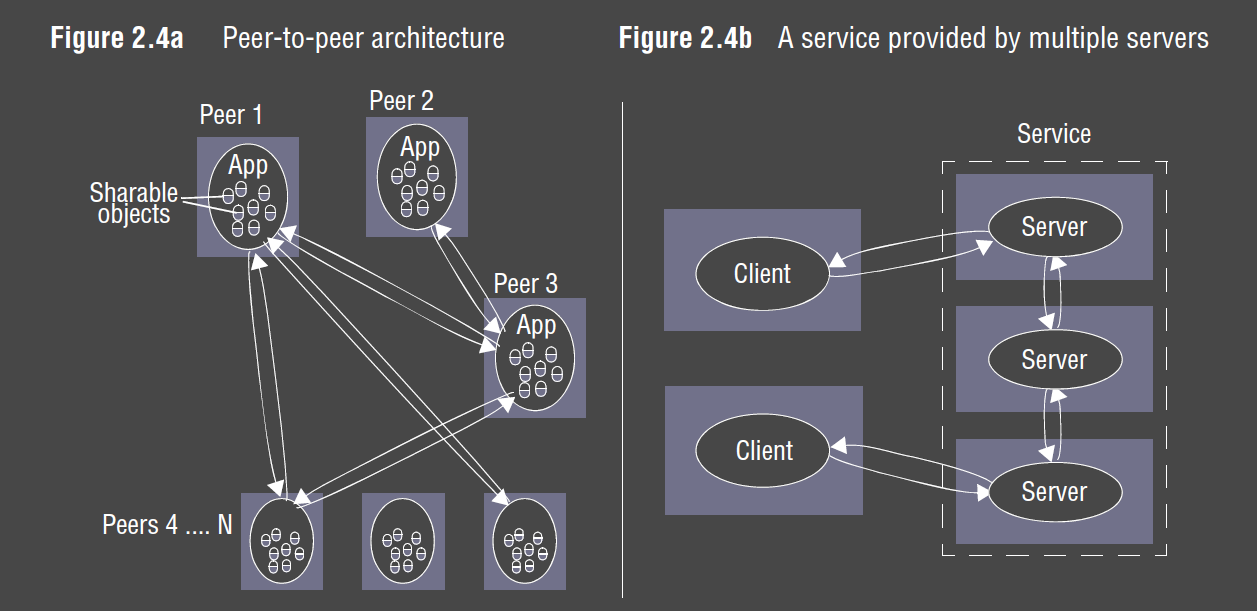
- how objects/services map onto physical distributed infrastructure
- crucial determinant of DS properties: performance, reliability, security
- where to place a given client/server in terms of machines/processes
- needs to account for e.g.:
- communication pattern between entities
- reliability of machines and current loading
- quality of communications
- mapping services to multiple servers: services can be implemented as multiple server
processes in separate host computers which interact to provide a service to clients
- increases capacity of system
- can partition/replicate across multiple hosts
- cluster: thousands of commodity processing boards
- e.g. data sharding
- cache: store of recently used objects that is closer to some clients than objects themselves
- new objects are added to the cache replacing existing objects (e.g. via LRU policy)
- reduce network traffic and server load
- may improve performance for client
- proxy server: increase availability/performance by reducing load on wide area network
- also used for: caching, hide identity of client, translation between APIs
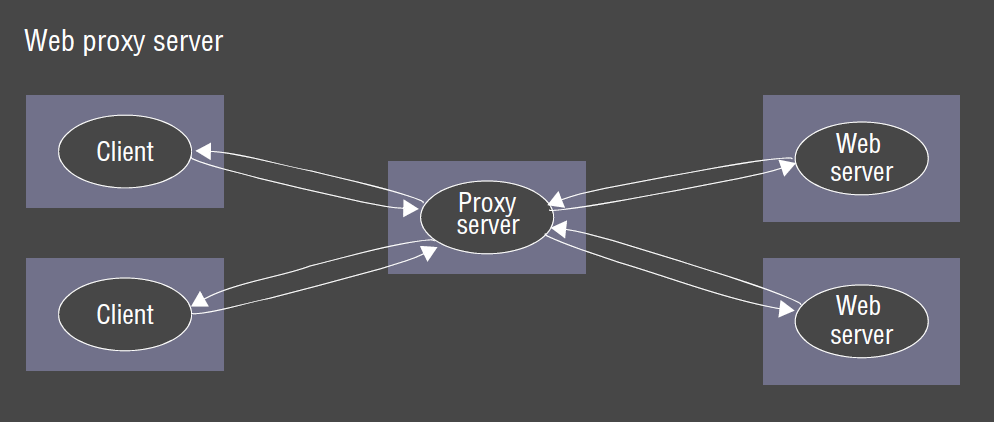
- mobile code: applets/Javascript
- good interactivity, allows asynchronous behaviour (AJAX)
- server provides code to browser which client browser runs to access services
- potential security threat
- mobile agent: running program (code + data) that travels from computer to computer,
carrying out a task on someones behalf, typically collecting data, eventually returning
with results
- reduced communication cost and time by replacing remote invocations with local ones
- big security threat, and web crawlers can still access resources successfully through remote invocations
- used to install/maintain software on computers within organisation
- not widely used anymore
Architectural Patterns
- patterns build on primitive architectural elements, providing composite recurring structures that work well in particular circumstances
Layering
- layering: partition system into layers, with a given layer making use of services provided
by the layer below. Higher layers are unaware of lower layer implementation details
- vertical organisation of services into service layers
- platform: lowest-level hardware/software; e.g. Intel x86/Linux
- middleware: software that masks heterogeneity and provides useful programming model.
- Processes interact to implement communication/resource-sharing.
- Provides building blocks for constructing software (value added services)
- naming
- security
- transactions
- persistent storage
- event service
- adds overhead: additional abstraction
- communication cannot be completely hidden so that error handling can occur properly
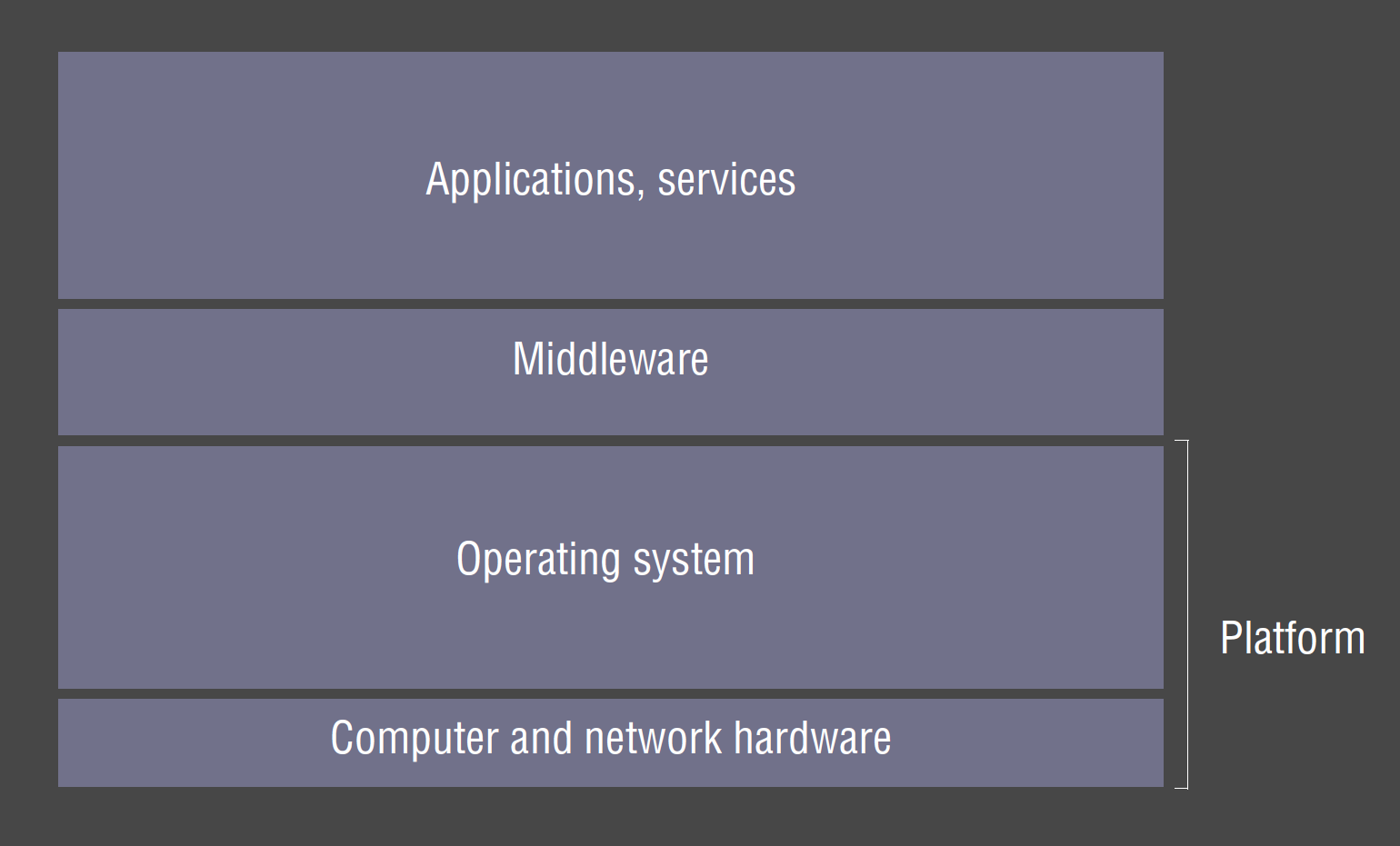
Tiered architecture
- tiered architecture: complements layering. Horizontal partitioning within a layer,
separating functionality into different servers. e.g.
- presentation logic: user interaction/view as presented to user
- application logic: app-specific processing/business logic
- data logic: persistent storage; DBMS
- 3-tier: separates each logical element into a distinct server
- only applicable to client-server; P2P is by definition a single tier
- thin client: software layer supporting window-based UI local to the user while accessing
services on a remote computer
- allows simple, low-cost devices to be used with a wide range of services
- poor performance for highly interactive graphical activities: CAD, image processing
- e.g. X terminals
- only does IO: draws things on screen/transmits mouse/keyboard
- server does all the computation
- Virtual Network Computing (VNC): remote access to GUI through VNC client via VNC protocol
- proxy: support location transparency in RPC/RMI
- proxy created in local address space to represent remote object: offers same interface as remote object, meaning application programmer calls on the proxy without knowing about the distributed nature
- also used for replication/caching
- brokerage: supports interoperability in complex distributed systems

Fundamental Models
- fundamental models allow you to analyse distributed systems regardless of architecture
- understand support of non-functional requirements
- e.g. how secure is the system? what attacks can it withstand?
- should only contain essential ingredients to understand/reason about aspect’s of system behaviour
- purpose
- make explicit relevant assumptions
- make generalisations concerning what is possible/impossible given those assumptions
- desirable properties
- general purpose algorithms
- aspects of distributed systems captured in fundamental models:
- interaction: account for inherent delays and absence of global clock
- failure: classify faults
- security: classify forms of attacks
Interaction Models
- model interaction between processes of a distributed system
- Message passing between processes produces
- communication: information flow
- coordination: synchronisation, ordering
- distributed systems composed of many processes can be described by distributed algorithms:
- steps taken by each process
- transmission of messages between processes
Performance of communication channels
- communication performance is often a limiting characteristic
- latency: delay between start of message transmission from process 1 and beginning of receipt by process 2
- bandwidth: information transmitted/time
- jitter: variation in time taken to deliver a series of messages
- most relevant to multimedia

Computer clocks and timing events
- each computer has its own internal clock
- timestamps between processes can vary
- time set differently initially
- differences in clock drify rate
- GPS can synchronise clocks ($\sim 1\mu s$). Doesn’t work inside buildings
- synchronise to time server
- time server synchronises with GPS and time infrastructure
- e.g. collaborative whiteboard
- take order of arrival at server if only the logical ordering matters, rather than exact order
- users can tolerate small errors
Synchronous System model
- assumes known bound for
- time to execute each step of process
- message transmission delay
- local clock drift rate
- view execution/message passing in terms of rounds. Everything is assumed to be completed before the next round commences
- time period could be long: e.g. 1 day for a sensor update system
- assumptions allow simplification of the system, making it easier to analyses
- if an operation didn’t complete in time: system is operating outside bounds of the model, may result in an error
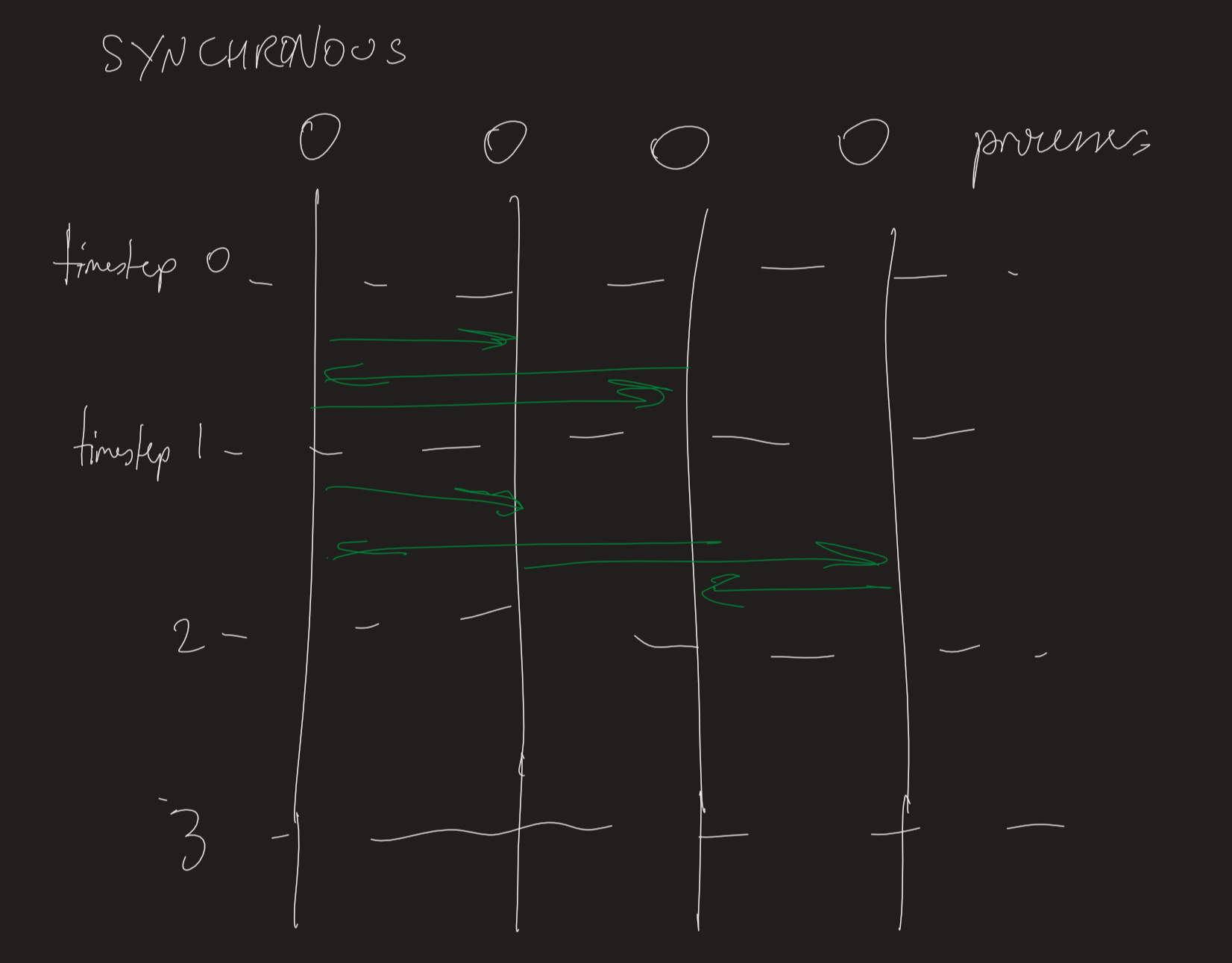
Asynchronous system model
- assumes no bound on:
- execution speed
- transmission delays
- clock drift rates
- processes can just proceed when they are ready: no notion of rounds
- exactly models the Internet: no intrinsic bound on server/network load
- actual distributed systems are very often asynchronous:
- processes need to share processors
- communication channels need to share the network
- necessitates queues for send/receive
- harder to program, but can simplify reasoning
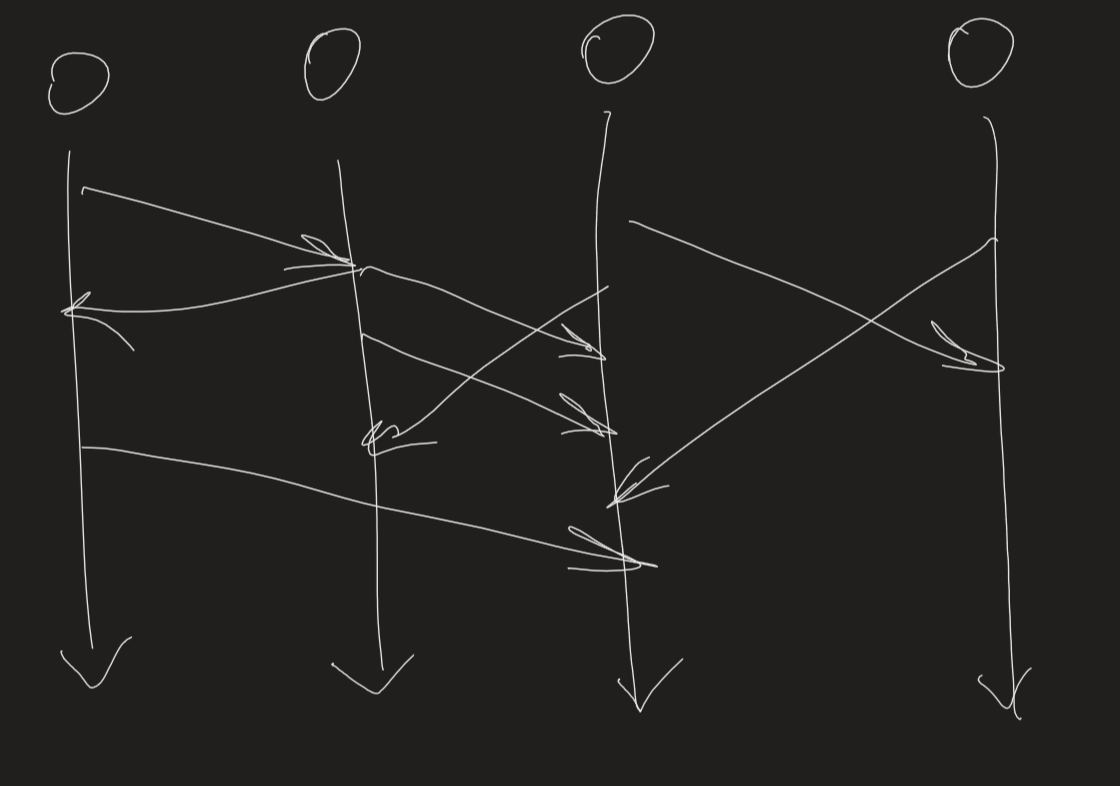
Event Ordering
- some applications require event ordering: i.e. whether an event at one process occurred before/after/concurrently with another event at another process
- messages may be received out of logical order: $m_1$ received after $m_3$ even though it was transmitted first
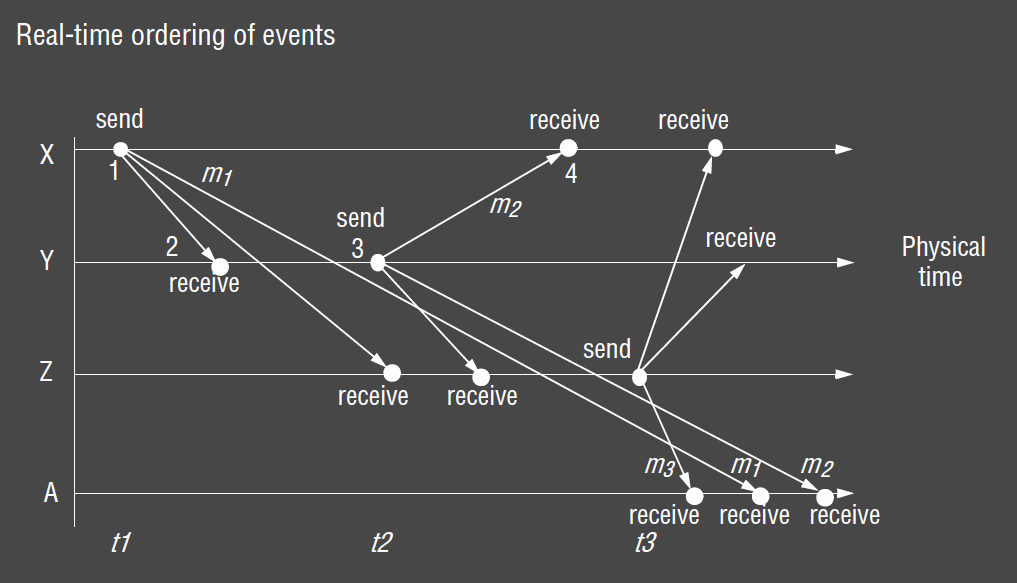
- if clocks could be synchronised, each message could simply be timestamped
- if clocks are roughly synchronised, timestamps will often be in correct order
- logical ordering: you know when events occur relative to others
- X sends $m_1$ before Y receives $m_1$
- Y sends $m_2$ before X receives $m_2$
- Y receives $m_1$ before sending $m_2$
- logical time: assign a number to each event based on its logical ordering (1-4 in diagram)
Failure Models
Define and classifies faults
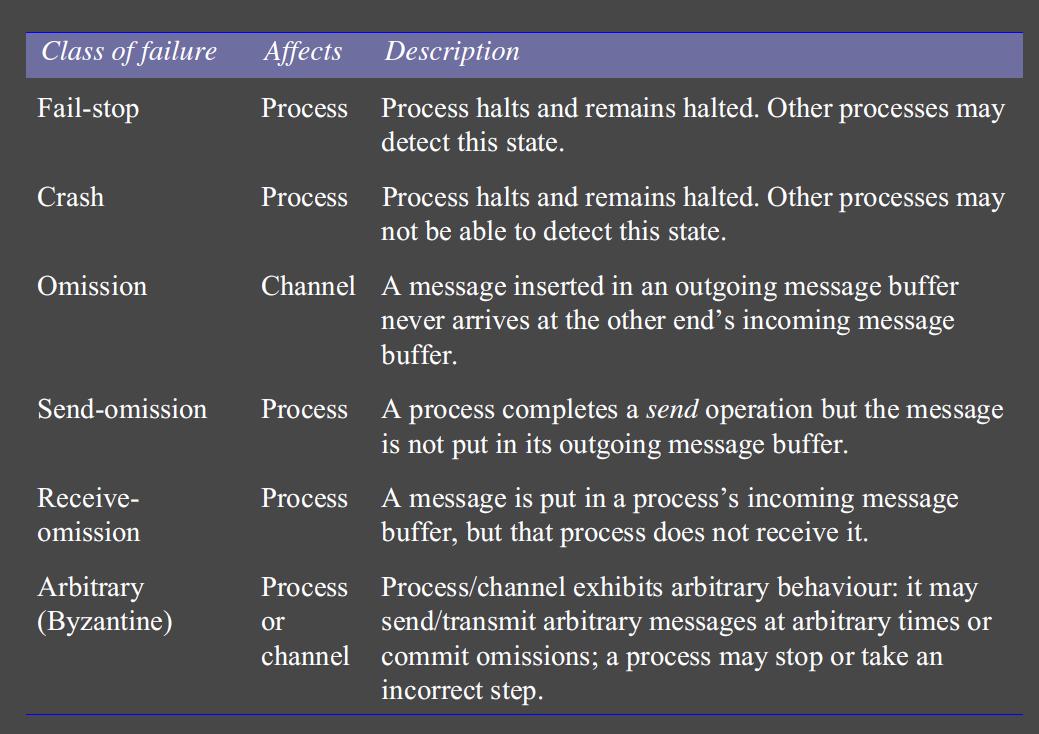
Omission failures
- process/communication channel fails to do what its expected to do
- process crash or network failure
- process failure:
- crash: may not be detectable
- fail-stop: crash can detect with certainty that the process crashed
- communication channel: failure occurs
- send omission failure: between sending process and outgoing message buffer
- channel omission failure: in channel
- receive omission failure: between incoming message buffer and receiving process

- repeated failures to respond during invocation: suggestive
- Detection: timeouts
- can only indicate a process is not responding: may have crashed, be still processing, or messages are en route
Arbitrary failures
- arbitrary failures: worst possible failure semantics
- process: arbitrarily omits/performs intended/unintended processing steps
- communication channel:
- message contents corrupted,
- non-existent messages delivered,
- messages delivered more than once
- rare due to checksums, sequence numbers, etc.
- any type of error may occur
- e.g. process sets wrong values in data items,
- e.g. process returns a wrong value in response to an invocation
Timing failures
- applicable to synchronous distributed systems, which have time limits set: execution time, message delivery time, clock drift rate
- timing failures: time limits exceeded
- may mean responses are unavailable to clients in specified time interval
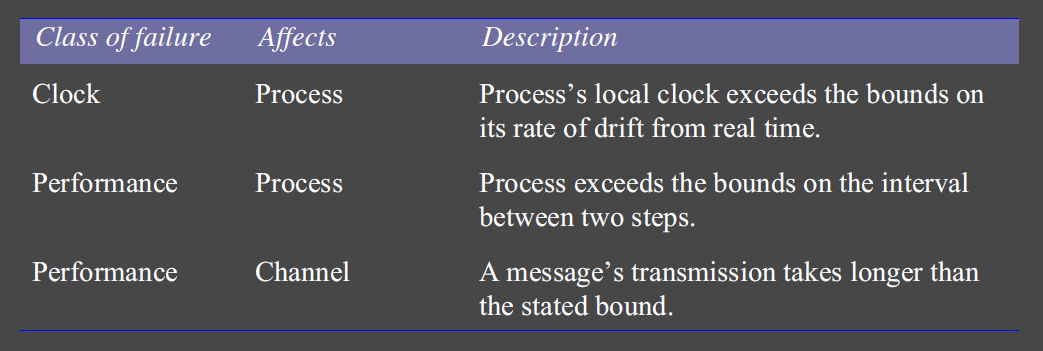
Reliable Communication
- validity: any message in outgoing buffer is eventually delivered to incoming message buffer
- integrity: message received is identical to the one sent
- no message is delivered twice
Security Models
- securing processes, communication channels
- protecting objects against unauthorised access
- access rights: specify who is allowed to perform operations on an object
- principal: each invocation is associated with a principal (user/process)
- server responsible for
- verifying identity of principal
- checking principal has sufficient access rights
- enemy/adversary: assumed to be capable of sending any message to any process or reading/copying any message between a pair of processes
Threats
- to processes: servers/clients cannot be certain of source of message, as addresses can be spoofed
- to channels: enemy can copy, alter, inject messages
- denial of service
- mobile code: corrupt server/service arbitrarily
Addressing threats
- cryptography, shared secrets, encryption
- authentication
- secure channel: encryption + authentication to build a secure channel as a service layer on top of existing communication channel
Questions
2.1 Provide three specific and contrasting examples of the increasing levels of heterogeneity experienced in contemporary distributed systems as defined in Section 2.2. page 39
- ubiquitous computing: e.g. smart fridges, mobile phones, tablets, laptops, … with significant differences in performance, input devices, etc.
- mobile computing: nodes may move from location to location
- cloud computing: pools of nodes that together provide a service
2.2 What problems do you foresee in the direct coupling between communicating entities that is implicit in remote invocation approaches? Consequently, what advantages do you anticipate from a level of decoupling as offered by space and time uncoupling? Note: you might want to revisit this answer after reading Chapters 5 and 6. page 43
- idempotency
2.3 Describe and illustrate the client-server architecture of one or more major Internet applications (for example, the Web, email or netnews). page 46
the Web: a client (i.e. a browser) opens TCP connections in order to send HTTP requests. A Web server, listening on port 80, responds with a HTTP response.
2.4 For the applications discussed in Exercise 2.1, what placement strategies are employed in implementing the associated services? page 48